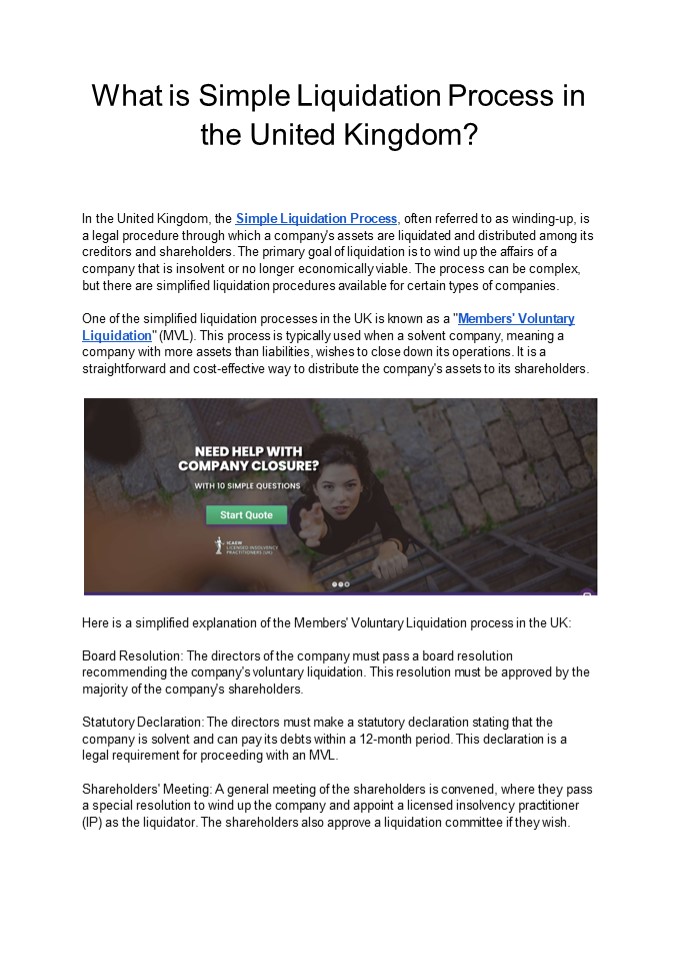What is Simple Liquidation Process in the United Kingdom? - PowerPoint PPT Presentation
Title:
What is Simple Liquidation Process in the United Kingdom?
Description:
In the United Kingdom, the Simple Liquidation Process, often referred to as winding-up, is a legal procedure through which a company's assets are liquidated and distributed among its creditors and shareholders. The primary goal of liquidation is to wind up the affairs of a company that is insolvent or no longer economically viable. The process can be complex, but there are simplified liquidation procedures available for certain types of companies. – PowerPoint PPT presentation
Number of Views:1
Title: What is Simple Liquidation Process in the United Kingdom?
1
What is Simple Liquidation Process in the United
Kingdom?
In the United Kingdom, the Simple Liquidation
Process, often referred to as winding-up, is a
legal procedure through which a company's assets
are liquidated and distributed among its
creditors and shareholders. The primary goal of
liquidation is to wind up the affairs of a
company that is insolvent or no longer
economically viable. The process can be complex,
but there are simplified liquidation procedures
available for certain types of companies. One of
the simplified liquidation processes in the UK is
known as a "Members' Voluntary Liquidation"
(MVL). This process is typically used when a
solvent company, meaning a company with more
assets than liabilities, wishes to close down its
operations. It is a straightforward and
cost-effective way to distribute the company's
assets to its shareholders.
Here is a simplified explanation of the Members'
Voluntary Liquidation process in the UK Board
Resolution The directors of the company must
pass a board resolution recommending the
company's voluntary liquidation. This resolution
must be approved by the majority of the
company's shareholders. Statutory Declaration
The directors must make a statutory declaration
stating that the company is solvent and can pay
its debts within a 12-month period. This
declaration is a legal requirement for
proceeding with an MVL. Shareholders' Meeting A
general meeting of the shareholders is convened,
where they pass a special resolution to wind up
the company and appoint a licensed insolvency
practitioner (IP) as the liquidator. The
shareholders also approve a liquidation committee
if they wish.
2
Notification to Companies House The company must
file specific forms with Companies House,
including a notice of the resolution to wind up
the company and a copy of the statutory
declaration. Liquidation Process The appointed
IP takes over the management of the company and
begins the process of realizing its assets. This
involves selling or transferring assets, paying
off creditors, and distributing any remaining
funds to shareholders. Final Accounts and Tax
Returns The liquidator prepares final accounts
and tax returns for the company, and once these
are approved by shareholders and creditors, the
liquidator applies for the company's
dissolution. Dissolution After completing all
necessary steps and settling all liabilities, the
company is dissolved and removed from the
Companies House register. This marks the formal
end of the company's existence. Members'
Voluntary Liquidation is a relatively
straightforward process for solvent companies
looking to close down their operations while
maximizing the return to shareholders. It
provides a structured and legally compliant way
to distribute assets and wind up the company's
affairs. However, it's crucial to seek
professional advice from an insolvency
practitioner or a qualified accountant
experienced in such procedures to ensure
compliance with all legal requirements and to
navigate the process effectively. The specific
steps and requirements may vary depending on the
circumstances and the nature of the company's
assets and liabilities.































